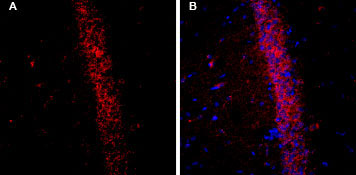Overview
- Peptide (C)RGPTITDKDRTKGPAE, corresponding to amino acid residues 578-593 of rat KCNQ2 (Accession O88943). Intracellular, C-terminus.

 Western blot analysis of rat brain (lanes 1 and 2), mouse brain (lanes 3 and 4), human KCNQ2 transfected HEK-293 cells (lanes 5 and 7) and human brain neuroblastoma SH-SY5Y cell line (lanes 6 and 8) lysates:1,3,5,6. Guinea pig Anti-KCNQ2 Antibody (#APC-050-GP), (1:200).
Western blot analysis of rat brain (lanes 1 and 2), mouse brain (lanes 3 and 4), human KCNQ2 transfected HEK-293 cells (lanes 5 and 7) and human brain neuroblastoma SH-SY5Y cell line (lanes 6 and 8) lysates:1,3,5,6. Guinea pig Anti-KCNQ2 Antibody (#APC-050-GP), (1:200).
2,4,7,8. Guinea pig Anti-KCNQ2 Antibody, preincubated with KCNQ2 Blocking Peptide (#BLP-PC050).
 Expression of KCNQ2 in rat brainImmunohistochemical staining of free-floating frozen rat hippocampal CA1 region sections using Guinea pig Anti-KCNQ2 Antibody (#APC-050-GP), (1:200). A. KCNQ2 staining (red) appears in the pyramidal layer (P). B. Nuclei are stained using DAPI as the counterstain (blue).
Expression of KCNQ2 in rat brainImmunohistochemical staining of free-floating frozen rat hippocampal CA1 region sections using Guinea pig Anti-KCNQ2 Antibody (#APC-050-GP), (1:200). A. KCNQ2 staining (red) appears in the pyramidal layer (P). B. Nuclei are stained using DAPI as the counterstain (blue).
- Kullmann, D.M. (2002) J. Mol. Brain 125, 1117.
- Robbins, J. (2001) Pharmacol. Ther. 90, 1.
- Wang, H.S. et al. (1998) Science 282, 1890.
The KCNQ family of voltage-gated K+ channels includes 5 known members: KCNQ1 to KCNQ5. Structurally, the KCNQ family belongs to the six transmembrane domain category of K+ channels.
KCNQ family members can form either homo- or heteromultimeric channels with different functional outcomes. For example KCNQ2 and KCNQ3 heteromultimers give rise to a much larger channel current than when either protein is expressed alone, probably due to enhanced plasma membrane expression of the combined channel. Indeed, KCNQ2/KCNQ3 heteromultimers are believed to be the molecular correlates of the so-called M current. This current is a K+ neuronal current that is strongly inhibited by the activation of the M1 subtype of the muscarinic acetylcholine receptor.
Mutations in either KCNQ2 or KCNQ3 are associated with a form of epilepsy known as Benign familial neonatal convulsions (BNFC).
Application key:
Species reactivity key:
Guinea pig Anti-KCNQ2 Antibody (#APC-050-GP, formerly AGP-065), raised in guinea pigs, is a highly specific antibody directed against an epitope of the rat KV7.2 channel. The antibody can be used in western blot and immunohistochemistry applications. It has been designed to recognize KCNQ2 from mouse, rat, and human samples.
The antigen used to immunize guinea pigs is the same as Anti-KCNQ2 Antibody (#APC-050) raised in rabbit. Our line of guinea pig antibodies enables more flexibility with our products such as multiplex staining studies, immunoprecipitation, etc.
